
Last month, a jet airliner was forced to emergency land in Lake Michigan because a bird was caught in one of the plane's engines. Every year hundreds of birds collide with planes. But it used to be worse. Much worse.

During the early days of the aviation industry, stewardesses were often caught in the jet engines of commercial flights. In 1972, birds and stewardesses accounted for 77% of all animal-airplane collisions.

Referred to as a SASH (Stewardess Airplane Strike Hazard), these incidents were often worse than hitting a duck. A 98-pound stewardess striking an aircraft going 150 MPH at lift-off generates the same devastating force as New Jersey Governor Chris Christie dropped from a height of 10 feet.
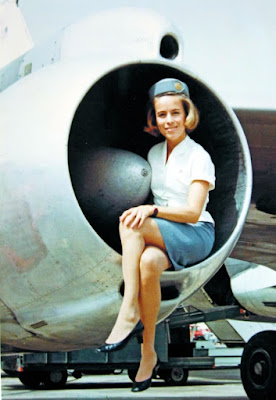
The first published acccount of a stewardess trapped in a jet engine occured in 1947 when Korean Air Flight 11 took off during a snow storm.
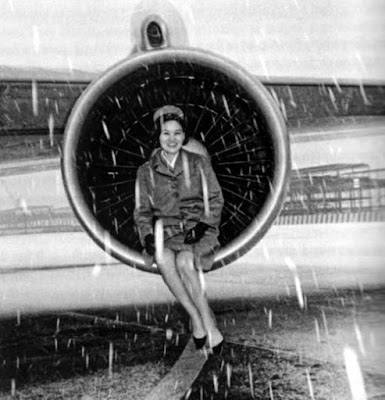
It was often said that, "Stews of a feather, flock together." Young, attractive stewardesses discovered that if they traveled in large groups their matching outfits would distract and disorient predatory pilots.
The largest number of stewardess strikes occured during the warmest months when stewardesses were most active and could often be found sunbathing on runways and airport tarmacs.
Not always fatal, these SASHs were so common that many airports maintained movable stairs to assist in removing the stewardess from the engine.

Where previously stewardesses were trapped one at a time, the Boeing 747 would often scoop up more than one crew member.

And occasionally entire flight crews collided with engines. Sadly, there was no coffee, tea or me during this SAS flight.
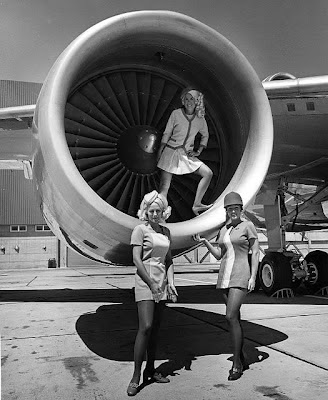
A memorable incident involving Suzie and Mary Jane Stanton, twin sisters from East Hunterdon, Georgia, caught the attention of the entire nation.

Often these incidents ended in the death of the stewardess. The surprising quickness and brutality of the collisions often left the victims eerily "frozen" in time -- like the residents of Pompeii. In 1961, after an emergency landing outside of Phoenix, the crew discovered this horrific scene.

Two pretty, young sisters kissing their dad good-bye as TWA Flight 341A took off on Runway 49 bound for Miami.

This also explains the smiling faces on the stewardesses in many of the old photographs. Forgotten by most of us, prior to deregulation and 9-11, flight crews were encouraged to smile, act pleasant and treat their customers with courtesy and respect.

These photographs are gruesome evidence of a simpler, perhaps happier, time.

The following is the only existing photograph of a stewardess not smiling.
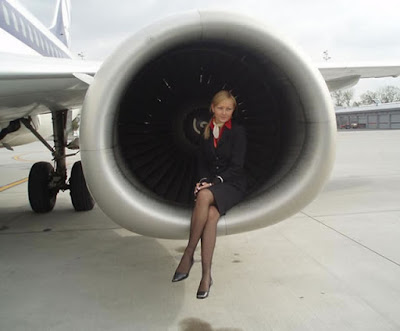
During the summer of 1962, two unrelated events convinced the world to finally address the escalating problem of stewardesses in jet engines.

A Finnish Air flight to Stockholm took off from a Helsinki Airport and inadvertantly scooped up two stewardesses and a pilot! This was the first recorded pilot-airplane collision fatality in over 25 years. While the loss of dozens of stewardesses a year was an accepted, although sad and unwelcome, hazard of the trade, pilots were considered a valuable asset by the airline industry at the time.
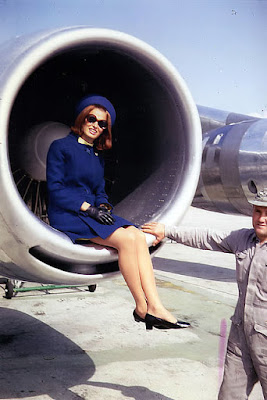
A shaken President Kennedy directed the FAA (Federal Aviation Agency) to solve the stewardess problem.

Given the Jackie Incident, the FAA initially targeted airline dress code. Mini skirts were out. Hot pants were in.


Where previously stewardesses were trapped one at a time, the Boeing 747 would often scoop up more than one crew member.

And occasionally entire flight crews collided with engines. Sadly, there was no coffee, tea or me during this SAS flight.

A memorable incident involving Suzie and Mary Jane Stanton, twin sisters from East Hunterdon, Georgia, caught the attention of the entire nation.

Often these incidents ended in the death of the stewardess. The surprising quickness and brutality of the collisions often left the victims eerily "frozen" in time -- like the residents of Pompeii. In 1961, after an emergency landing outside of Phoenix, the crew discovered this horrific scene.

Two pretty, young sisters kissing their dad good-bye as TWA Flight 341A took off on Runway 49 bound for Miami.

This also explains the smiling faces on the stewardesses in many of the old photographs. Forgotten by most of us, prior to deregulation and 9-11, flight crews were encouraged to smile, act pleasant and treat their customers with courtesy and respect.

These photographs are gruesome evidence of a simpler, perhaps happier, time.

The following is the only existing photograph of a stewardess not smiling.

During the summer of 1962, two unrelated events convinced the world to finally address the escalating problem of stewardesses in jet engines.

A Finnish Air flight to Stockholm took off from a Helsinki Airport and inadvertantly scooped up two stewardesses and a pilot! This was the first recorded pilot-airplane collision fatality in over 25 years. While the loss of dozens of stewardesses a year was an accepted, although sad and unwelcome, hazard of the trade, pilots were considered a valuable asset by the airline industry at the time.
Closer to home, Jackie Bouvier Kennedy, the First Lady, was involved in a non-fatal collision when she was dressed a little too much like an Eastern Airlines stewardess.

A shaken President Kennedy directed the FAA (Federal Aviation Agency) to solve the stewardess problem.

Given the Jackie Incident, the FAA initially targeted airline dress code. Mini skirts were out. Hot pants were in.
Sadly, hot pants were not the solution.

Jet design was evaluated. An alert FAA investigator noticed that some joker had painted a swirly-whirly design on most of the engines. A design that could easily hypnotize an unsuspecting stewardess.
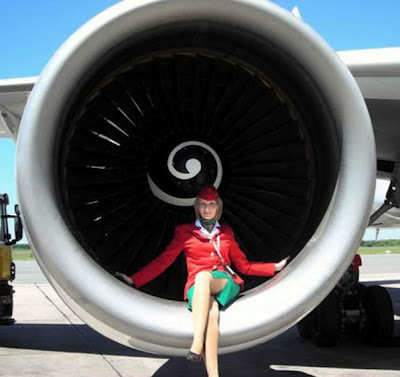
The FAA made the painting of psychedelic art and other hippy stuff onto airplanes illegal and Europe soon followed with their own guidelines.

Unfortunately, those swirly-whirly things were not the problem and hot pants fell out of favor.
The FAA was stumped -- until somebody remembered that Delta Airlines facility engineer Glenn Hughie invented the jet bridge back in 1959.

Jet bridges saved lives, stewardesses became flight attendants, and an early, forgotten chapter in the history of aviation was complete.

The FAA made the painting of psychedelic art and other hippy stuff onto airplanes illegal and Europe soon followed with their own guidelines.

Unfortunately, those swirly-whirly things were not the problem and hot pants fell out of favor.
The FAA was stumped -- until somebody remembered that Delta Airlines facility engineer Glenn Hughie invented the jet bridge back in 1959.

Jet bridges saved lives, stewardesses became flight attendants, and an early, forgotten chapter in the history of aviation was complete.



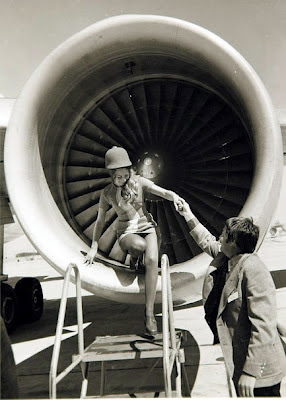
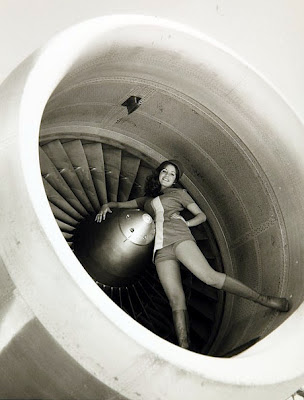










Love it!! Thanks for the laughs! Terri (former F/A)
ReplyDeleteTerri,
ReplyDeleteThanks for the comment!
Honestly, I was afraid flight attendants might be offended.
Did you ever pose in an engine? And what would happen if somebody accidently turned it on?
Bob
every f/a i know, including myself has at least one photo in an engine! thankfully not in hotpants!denise
ReplyDeleteDenise,
ReplyDeleteThanks for the comment!
Do you think that there are also thousands of photos of mechanics and pilots posing in engines that just don't get posted on the web for the obvious reasons?
Bob
got a few of me too. and yes one in hot pants.
ReplyDeletethoes were the days.
Polly
Polly,
ReplyDeleteThanks for the comment!
Bob
I did this in begining of my career in a polo shirt, shorts and white tennies. UGH!! Still flying but wear a nice dress. Thank goodness. Shorts are so unprofessional looking. Get a clue
ReplyDeleteis really unbealiveable, and SAD.
ReplyDeleteHow many stewardesses had to been killed (and ONE pilot) until some FAA "genius" remembered that in 1959 Glenn Hughie invented the jet bridge?...
I have searched in the Internet the "Suzie and Mary Jane Stanton" names with no luck. Anyone could provide me some information about this incident? My email is grl777@gmail.com
Thanks a lot for this interesting article!
This is an interesting look at aviation history.
ReplyDelete